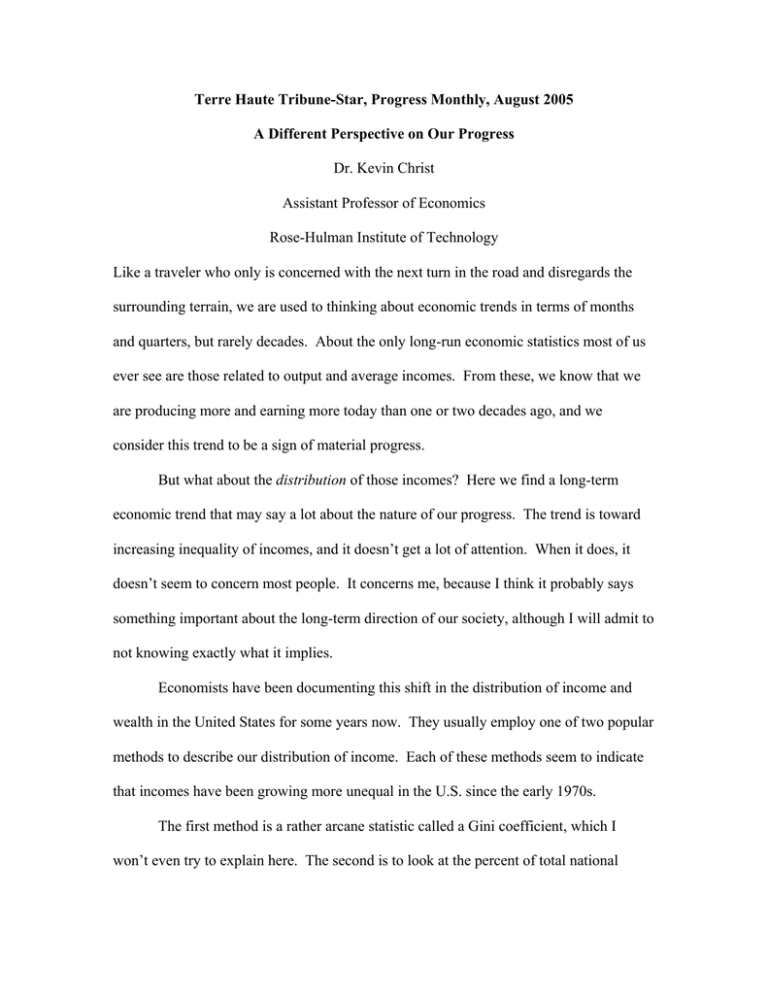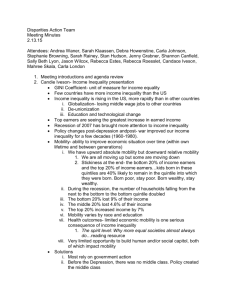Terre Haute Tribune-Star, Progress Monthly, August 2005 Dr. Kevin Christ
advertisement

Terre Haute Tribune-Star, Progress Monthly, August 2005 A Different Perspective on Our Progress Dr. Kevin Christ Assistant Professor of Economics Rose-Hulman Institute of Technology Like a traveler who only is concerned with the next turn in the road and disregards the surrounding terrain, we are used to thinking about economic trends in terms of months and quarters, but rarely decades. About the only long-run economic statistics most of us ever see are those related to output and average incomes. From these, we know that we are producing more and earning more today than one or two decades ago, and we consider this trend to be a sign of material progress. But what about the distribution of those incomes? Here we find a long-term economic trend that may say a lot about the nature of our progress. The trend is toward increasing inequality of incomes, and it doesn’t get a lot of attention. When it does, it doesn’t seem to concern most people. It concerns me, because I think it probably says something important about the long-term direction of our society, although I will admit to not knowing exactly what it implies. Economists have been documenting this shift in the distribution of income and wealth in the United States for some years now. They usually employ one of two popular methods to describe our distribution of income. Each of these methods seem to indicate that incomes have been growing more unequal in the U.S. since the early 1970s. The first method is a rather arcane statistic called a Gini coefficient, which I won’t even try to explain here. The second is to look at the percent of total national income accruing to the top 10% or top 1% of earners. The table presents a snapshot of the U.S. distribution over a very long period of time, using this second method. It comes from a study by economists Thomas Piketty and Emmanuel Saez. It shows that between 1920 and 1970 income disparities declined, but that since 1970 a higher percentage of total income is accruing to a smaller percentage of the population. More than a few people who have studied this trend have linked it somehow to a slowdown in productivity growth in the 1970s and early 1980s. By this logic, however, the trend toward increasing income inequality should have started to reverse as productivity picked up in the late 1990s. It didn’t. The usual assumption in this respect is that rising productivity allows businesses to pay higher wages or to improve profits. It seems that since the 1970s, the scales have been tipped more towards the latter of these two outcomes. Between 1950 and 1974, labor productivity and real hourly compensation grew at about the same rate. Higher productivity really was associated with higher real wages – and a rising tide lifted all boats. Since 1974, however, as labor productivity has grown by 82%, real hourly compensation has grown by only 46%. Over this latter period, corporate profits have grown much faster than compensation. I think the consequences for the distribution of income are obvious, but will admit to not fully knowing why this change has occurred. As I said, this long-term trend doesn’t seem to concern many people. Ian Maitland, a commentator writing recently in the Minneapolis Star-Tribune, brushed off concerns over income inequality in a column entitled “Economic disparity isn’t all bad.” He touched on the usual responses to income disparities: they are a natural outcome of underlying disparities in skills, they result from choices people make in the marketplace, and they are fine so long as there is mobility between the categories of poor, middle class, and super rich. After all, as he lightheartedly noted, J.K. Rowling, the author of the Harry Potter books and now one of the wealthiest people in the world, was once a single mother on welfare. Such Horatio Alger success stories are nice, but analysis by anecdote only takes one so far. Without going into the boring details of other economic research, income mobility – the movement of individuals between various income categories – seems to have declined in the 1990s. Most social scientists would agree with economist Paul Krugman, who wrote last year that “the myth of income mobility has always exceeded reality.” Furthermore, the income distribution in a society is not merely the outcome of individual choices in the marketplace. It is also influenced by collective choices in the political sphere. It probably is not an accident that the rise in income inequality roughly corresponds to our reduction in the progessivity of our income tax system. And exactly how do you think income mobility is affected as we “choose” to reduce funding to public education? Of course, there are real social costs to reducing inequality – higher taxes on the rich reduce their incentives to earn, for example. But might not there also be real social costs associated with allowing inequality to rise? As I often say to my students, I’ll leave that for you to consider as an independent exercise. 1920 1970 2000 Share of Total Income by … Top 10% of earners Top 1% of earners Top 0.01% of earners 38.1% 14.5% 1.7% 31.5% 7.8% 0.5% 43.9% 16.9% 3.1%







